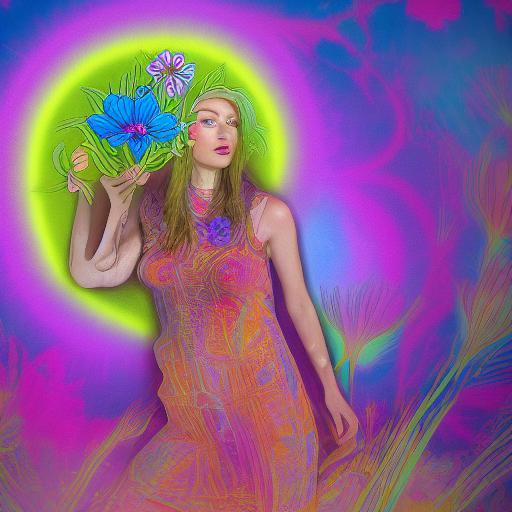How to write this prompt?
How to write a prompt like this in detail and point form:
- Overall Description:
- The image is an ultra-realistic aerial view painting of a woman standing in a field of flowers.
- The woman is a psychedelic elf.
- She is holding a blue flower in her hand.
- She is wearing a rainbow-colored dress.
- The lighting is direct sunlight, illuminating the vibrant colors of the flowers and the woman’s dress.
- The artwork is a digital 2D psychedelic art, inspired by Android Jones’ style.
- The image is rendered with Unreal Engine, giving it a highly realistic and detailed look.
- Specifics:
- The woman is an elf and has a psychedelic appearance.
- The field of flowers is vibrant and colorful, with direct sunlight to enhance the colors.
- The woman is holding a blue flower in her hand, which is a focal point of the image.
- The woman is wearing a rainbow-colored dress, adding to the psychedelic theme.
- The Unreal Engine is used to render the image, making it highly realistic and detailed.
- Influences:
- The psychedelic appearance of the woman is inspired by the style of Android Jones.
- The use of direct sunlight enhances the vibrancy of the colors in the image.
- The focus on the blue flower in the woman’s hand draws attention to it.
- The rainbow-colored dress adds to the overall psychedelic theme of the image.
- The use of Unreal Engine makes the image highly realistic and detailed.
By including specific details and influences, a prompt like this can guide an AI model to generate an image that matches the desired aesthetic and style. The choice of words and the level of detail can also affect the overall outcome of the generated image.
What is Android Jones’ style?
Android Jones is an American artist who is known for his psychedelic digital art. His style incorporates vivid colors, intricate details, and trippy imagery, often featuring spiritual and mystical themes.
How to create an ultra-realistic aerial view painting?
To create an ultra-realistic aerial view painting, you can use a variety of digital painting software and techniques. One approach is to start with a detailed sketch or reference photo of the scene, and then use digital brushes and textures to add layers of color and detail. You can also experiment with lighting and shading to create a sense of depth and atmosphere in the image.
Why do some artists use Unreal Engine to render their digital art?
Unreal Engine is a powerful game engine that can be used to create highly realistic and interactive digital experiences. Some artists use Unreal Engine to render their digital art because it offers advanced lighting and shading capabilities, as well as real-time rendering and interactivity. This can result in highly detailed and immersive digital art that feels almost like a real-world experience.
Do I need to have technical knowledge or programming skills to use AI art generation prompts?
No, you do not need to have technical knowledge or programming skills to use AI art generation prompts. Many AI art generation tools and platforms have user-friendly interfaces that allow you to input a prompt or image description and generate an artwork with a few clicks. However, having some understanding of the capabilities and limitations of AI art generation can help you create more effective prompts and refine the output.
Are there any copyright issues with using AI-generated art?
Yes, there can be copyright issues with using AI-generated art. In many cases, the copyright of the generated artwork belongs to the creator of the AI model or the owner of the training data used to create the model. Additionally, if the AI-generated art incorporates elements of copyrighted material, such as images or text, it may infringe on the copyright of the original creator. It is important to be aware of these issues and to obtain permission or licenses as necessary before using or distributing AI-generated art.
Visualize your ideas like never before with the power of AI-generated art and design tools from Visual Paradigm Online. Elevate your designs to the next level by effortlessly integrating stunning graphics with just a few clicks. With a user-friendly interface and a vast selection of design templates and assets at your disposal, you can explore and experiment with various styles and layouts until you create the perfect masterpiece. Discover the limitless potential of AI-generated art and transform your creative vision into reality with Visual Paradigm Online.


